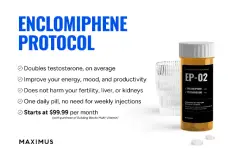madman
Super Moderator
* Our initial experience with TLANDO TU capsules for the treatment of hypogonadism shows it is safe and efficacious with unique post treatment blood test changes, including a decrease in SHBG in both groups.
* Interestingly, while calculated free testosterone did not change in the “previous TRT” group, SHBG decreased significantly to a similar extent as the “no previous TRT” group. Hematocrit and PSA values remained within the normal range. Hypogonadal symptoms were resolved in 76% of patients using TLANDO. There were reports of hair thinning (4), acne (3), polycythemia (2), gynecomastia (1) and increased blood pressure (1). No one had worsening of BPH /LUTS.

CHANGES IN BLOOD TEST PROFILES WITH USE OF TESTOSTERONE UNDECANOATE CAPSULES (TLANDO) IN MEN WITH HYPOGONADISM
James Weinberger*, Noel N. Kim, Mia Neustein, Sue W. Goldstein,Irwin Goldstein, San Diego, CA
INTRODUCTION AND OBJECTIVES
TLANDO is an FDA-approved oral formulation of testosterone undecanoate (TU) indicated for adult males with primary or secondary hypogonadism. Two pills (112.5 mg each) are taken twice daily without the need for titration. The pharmacokinetic profile of TLANDO is more similar to the variation of normal diurnal testosterone physiology than that achieved by other delivery systems. This oil-based capsule of TU avoids first pass hepatic metabolism. We wished to study the effect of TLANDO on hypogonadal symptoms and hormones/blood test values.
METHODS
A chart review was performed to examine outcome of TU use on hypogonadal symptoms and hormone blood test values for testosterone, sex hormone binding globulin (SHBG), dihydrotestosterone (DHT) as well as hematocrit and prostate specific antigen (PSA) measured prior to and within 3 months of initiating TLANDO treatment, separating those who had and had not been on testosterone replacement therapy (TRT) previously.
RESULTS
A total of 41 patients (mean age=60.2±9 years) were studied, including 15 who had been on TRT previously. Significant increases were noted in the “no previous TRT” group for total testosterone, DHT, and calculated free testosterone (Figure 1). The “previous TRT” group transitioning to TLANDO predictably maintained total testosterone levels, but DHT levels nevertheless increased 1.9-fold, approaching statistical significance (p=0.06). Interestingly, while calculated free testosterone did not change in the “previous TRT” group, SHBG decreased significantly to a similar extent as the “no previous TRT” group. Hematocrit and PSA values remained within the normal range. Hypogonadal symptoms were resolved in 76% of patients using TLANDO. There were reports of hair thinning (4), acne (3), polycythemia (2), gynecomastia (1) and increased blood pressure (1). No one had worsening of BPH /LUTS.
CONCLUSIONS
Our initial experience with TLANDO TU capsules for the treatment of hypogonadism shows it is safe and efficacious with unique post treatment blood test changes, including a decrease in SHBG in both groups.
* Interestingly, while calculated free testosterone did not change in the “previous TRT” group, SHBG decreased significantly to a similar extent as the “no previous TRT” group. Hematocrit and PSA values remained within the normal range. Hypogonadal symptoms were resolved in 76% of patients using TLANDO. There were reports of hair thinning (4), acne (3), polycythemia (2), gynecomastia (1) and increased blood pressure (1). No one had worsening of BPH /LUTS.
CHANGES IN BLOOD TEST PROFILES WITH USE OF TESTOSTERONE UNDECANOATE CAPSULES (TLANDO) IN MEN WITH HYPOGONADISM
James Weinberger*, Noel N. Kim, Mia Neustein, Sue W. Goldstein,Irwin Goldstein, San Diego, CA
INTRODUCTION AND OBJECTIVES
TLANDO is an FDA-approved oral formulation of testosterone undecanoate (TU) indicated for adult males with primary or secondary hypogonadism. Two pills (112.5 mg each) are taken twice daily without the need for titration. The pharmacokinetic profile of TLANDO is more similar to the variation of normal diurnal testosterone physiology than that achieved by other delivery systems. This oil-based capsule of TU avoids first pass hepatic metabolism. We wished to study the effect of TLANDO on hypogonadal symptoms and hormones/blood test values.
METHODS
A chart review was performed to examine outcome of TU use on hypogonadal symptoms and hormone blood test values for testosterone, sex hormone binding globulin (SHBG), dihydrotestosterone (DHT) as well as hematocrit and prostate specific antigen (PSA) measured prior to and within 3 months of initiating TLANDO treatment, separating those who had and had not been on testosterone replacement therapy (TRT) previously.
RESULTS
A total of 41 patients (mean age=60.2±9 years) were studied, including 15 who had been on TRT previously. Significant increases were noted in the “no previous TRT” group for total testosterone, DHT, and calculated free testosterone (Figure 1). The “previous TRT” group transitioning to TLANDO predictably maintained total testosterone levels, but DHT levels nevertheless increased 1.9-fold, approaching statistical significance (p=0.06). Interestingly, while calculated free testosterone did not change in the “previous TRT” group, SHBG decreased significantly to a similar extent as the “no previous TRT” group. Hematocrit and PSA values remained within the normal range. Hypogonadal symptoms were resolved in 76% of patients using TLANDO. There were reports of hair thinning (4), acne (3), polycythemia (2), gynecomastia (1) and increased blood pressure (1). No one had worsening of BPH /LUTS.
CONCLUSIONS
Our initial experience with TLANDO TU capsules for the treatment of hypogonadism shows it is safe and efficacious with unique post treatment blood test changes, including a decrease in SHBG in both groups.














